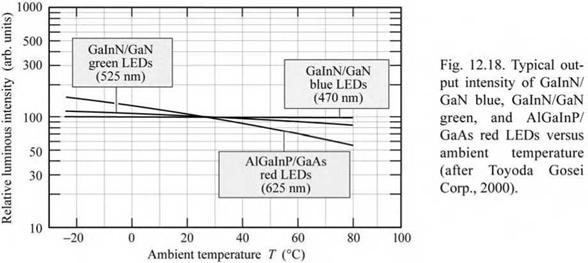Optical characteristics of high-brightness LEDs
 29 марта, 2014
29 марта, 2014  admin
admin Optical emission spectra of red AlGaInP and green and blue GaInN LEDs are shown in Fig. 12.16 (Toyoda Gosei, 2000). Comparison of the emission spectra reveals that the green LED has a wider emission spectrum than either the blue or the red LED. This can be attributed to the well-known difficulties of growing GaInN with a high In content. It has been found that In-rich clusters or quantum dots form during the growth of GaInN, especially in GaInN with a high In
content. It is known that the formation of such In clusters depends strongly on the growth conditions.
|
|
All LEDs shown in Fig. 12.16 have an active region composed of a semiconductor alloy. Alloy broadening, i. e. the broadening of the emission band due to random fluctuations of the chemical composition of the active material, will lead to spectral broadening that goes beyond the 1.8 kT linewidth expected for thermally broadened emission bands.
|
|
|
Fig. 12.17. Typical light output power vs. injection current of GalnN/ GaN blue, GalnN/GaN green, and AlGaInP/ GaAs red LEDs at room temperature (adopted from Toyoda Gosei Corp., 2000). |
The light power versus injection current is shown in Fig. 12.17. A linear dependence with unit slope, i. e. unit differential quantum efficiency, is expected for light-versus-current curves in ideal LEDs. The unit-slope line is represented by the dashed line in Fig. 12.17. The mature
AlGaInP LED closely follows the unit-slope line. However, the green LED has a large deviation from the unit differential quantum efficiency slope due to the lower maturity of the GaInN material system, especially with high concentrations of In.
The temperature dependence of the optical emission intensity is shown in Fig. 12.18. The figure reveals that III-V nitride diodes have a much weaker temperature dependence than the AlGaInP LED. Two factors contribute to the weaker temperature dependence. Firstly, the active - to-confinement barriers are higher in the wide-gap III-V nitride material system than in other III-V material systems. Consequently, carriers in the GaInN active region are very well confined. Thus carrier leakage out of the well and carrier overflow are of little relevance in GaInN LEDs. Secondly, AlGaInP has a direct-indirect transition of the bandgap at about 555 nm. At elevated temperatures, the indirect valleys become increasingly populated so that the radiative efficiency decreases.
|
|




 Опубликовано в
Опубликовано в